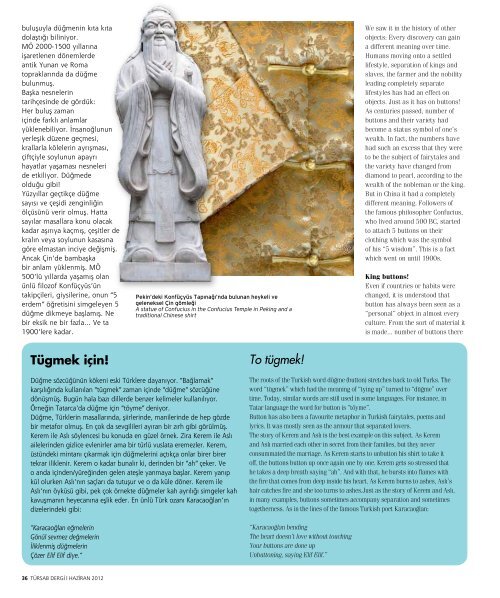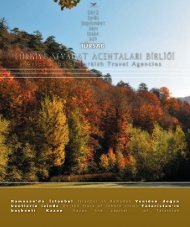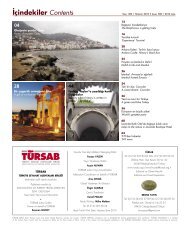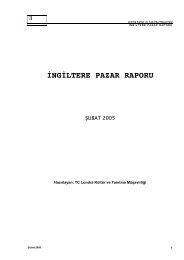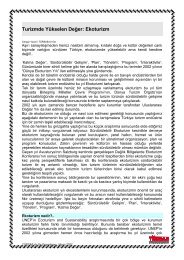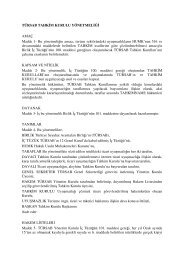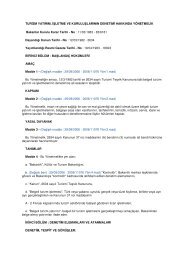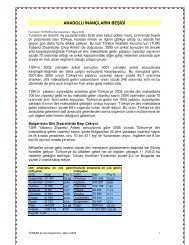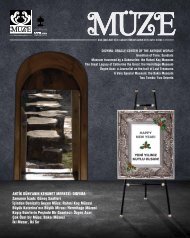Yeni Laleli New Laleli - Türkiye Seyahat Acentaları Birliği
Yeni Laleli New Laleli - Türkiye Seyahat Acentaları Birliği
Yeni Laleli New Laleli - Türkiye Seyahat Acentaları Birliği
You also want an ePaper? Increase the reach of your titles
YUMPU automatically turns print PDFs into web optimized ePapers that Google loves.
uluşuyla düğmenin kıta kıta<br />
dolaştığı biliniyor.<br />
MÖ 2000-1500 yıllarına<br />
işaretlenen dönemlerde<br />
antik Yunan ve Roma<br />
topraklarında da düğme<br />
bulunmuş.<br />
Başka nesnelerin<br />
tarihçesinde de gördük:<br />
Her buluş zaman<br />
içinde farklı anlamlar<br />
yüklenebiliyor. İnsanoğlunun<br />
yerleşik düzene geçmesi,<br />
krallarla kölelerin ayrışması,<br />
çiftçiyle soylunun apayrı<br />
hayatlar yaşaması nesneleri<br />
de etkiliyor. Düğmede<br />
olduğu gibi!<br />
Yüzyıllar geçtikçe düğme<br />
sayısı ve çeşidi zenginliğin<br />
ölçüsünü verir olmuş. Hatta<br />
sayılar masallara konu olacak<br />
kadar aşırıya kaçmış, çeşitler de<br />
kralın veya soylunun kasasına<br />
göre elmastan inciye değişmiş.<br />
Ancak Çin’de bambaşka<br />
bir anlam yüklenmiş. MÖ<br />
500’lü yıllarda yaşamış olan<br />
ünlü filozof Konfüçyüs’ün<br />
takipçileri, giysilerine, onun “5<br />
erdem” öğretisini simgeleyen 5<br />
düğme dikmeye başlamış. Ne<br />
bir eksik ne bir fazla... Ve ta<br />
1900’lere kadar.<br />
Pekin’deki Konfüçyüs Tapınağı’nda bulunan heykeli ve<br />
geleneksel Çin gömleği<br />
A statue of Confucius in the Confucius Temple in Peking and a<br />
traditional Chinese shirt<br />
We saw it in the history of other<br />
objects: Every discovery can gain<br />
a different meaning over time.<br />
Humans moving onto a settled<br />
lifestyle, separation of kings and<br />
slaves, the farmer and the nobility<br />
leading completely separate<br />
lifestyles has had an effect on<br />
objects. Just as it has on buttons!<br />
As centuries passed, number of<br />
buttons and their variety had<br />
become a status symbol of one’s<br />
wealth. In fact, the numbers have<br />
had such an excess that they were<br />
to be the subject of fairytales and<br />
the variety have changed from<br />
diamond to pearl, according to the<br />
wealth of the nobleman or the king.<br />
But in China it had a completely<br />
different meaning. Followers of<br />
the famous philosopher Confucius,<br />
who lived around 500 BC, started<br />
to attach 5 buttons on their<br />
clothing which was the symbol<br />
of his “5 wisdom”. This is a fact<br />
which went on until 1900s.<br />
King buttons!<br />
Even if countries or habits were<br />
changed, it is understood that<br />
button has always been seen as a<br />
“personal” object in almost every<br />
culture. From the sort of material it<br />
is made... number of buttons there<br />
Tügmek için!<br />
To tügmek!<br />
Düğme sözcüğünün kökeni eski Türklere dayanıyor. “Bağlamak”<br />
karşılığında kullanılan “tügmek” zaman içinde “düğme” sözcüğüne<br />
dönüşmüş. Bugün hala bazı dillerde benzer kelimeler kullanılıyor.<br />
Örneğin Tatarca’da düğme için “töyme” deniyor.<br />
Düğme, Türklerin masallarında, şiirlerinde, manilerinde de hep gözde<br />
bir metafor olmuş. En çok da sevgilileri ayıran bir zırh gibi görülmüş.<br />
Kerem ile Aslı söylencesi bu konuda en güzel örnek. Zira Kerem ile Aslı<br />
ailelerinden gizlice evlenirler ama bir türlü vuslata eremezler. Kerem,<br />
üstündeki mintanı çıkarmak için düğmelerini açtıkça onlar birer birer<br />
tekrar iliklenir. Kerem o kadar bunalır ki, derinden bir “ah” çeker. Ve<br />
o anda içinden/yüreğinden gelen ateşle yanmaya başlar. Kerem yanıp<br />
kül olurken Aslı’nın saçları da tutuşur ve o da küle döner. Kerem ile<br />
Aslı’nın öyküsü gibi, pek çok örnekte düğmeler kah ayrılığı simgeler kah<br />
kavuşmanın heyecanına eşlik eder. En ünlü Türk ozanı Karacaoğlan’ın<br />
dizelerindeki gibi:<br />
“Karacaoğlan eğmelerin<br />
Gönül sevmez değmelerin<br />
İliklenmiş düğmelerin<br />
Çözer Elif Elif diye.”<br />
The roots of the Turkish word düğme (button) stretches back to old Turks. The<br />
word “tügmek” which had the meaning of “tying up” turned to “düğme” over<br />
time. Today, similar words are still used in some languages. For instance, in<br />
Tatar language the word for button is “töyme”.<br />
Button has also been a favourite metaphor in Turkish fairytales, poems and<br />
lyrics. It was mostly seen as the armour that separated lovers.<br />
The story of Kerem and Aslı is the best example on this subject. As Kerem<br />
and Aslı married each other in secret from their families, but they never<br />
consummated the marriage. As Kerem starts to unbutton his shirt to take it<br />
off, the buttons button up once again one by one. Kerem gets so stressed that<br />
he takes a deep breath saying “ah”. And with that, he bursts into flames with<br />
the fire that comes from deep inside his heart. As Kerem burns to ashes, Aslı’s<br />
hair catches fire and she too turns to ashes.Just as the story of Kerem and Aslı,<br />
in many examples, buttons sometimes accompany separation and sometimes<br />
togetherness. As in the lines of the famous Turkish poet Karacaoğlan:<br />
“Karacaoğlan bending<br />
The heart doesn’t love without touching<br />
Your buttons are done up<br />
Unbuttoning, saying Elif Elif.”<br />
36 TÜRSAB DERGİ | HAZİRAN 2012


